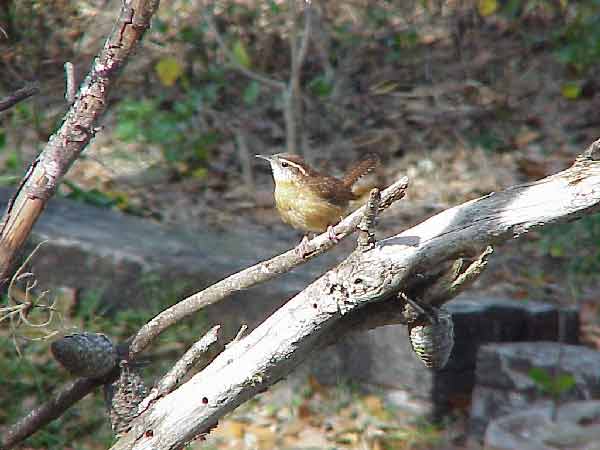
Attracting Wrens
to Your Yard
by Linda Vanderveen
Just a few centuries ago, people believed that life came spontaneously from nonliving material. Aristotle believed that swallows came from the mud at the bottom of ponds. Migration was a concept that was unknown. People didn't have an explanation for birds that suddenly appeared on the scene. A seventeenth century scientist, van Helmont, even went so far as to create a "recipe" for creating mice. One went about this by adding a few bits of grain to some dirty rags. Toss the whole mess in a dark corner, in a few days mice will appear!
Well, attracting wrens is a lot like the spontaneous creation of mice. Wrens are provided with food and nesting sites incidentally, just by the way we humans live. Wrens thrive on untidiness, so those of you with immaculate yards will have trouble creating wrens. Wrens typically nest in natural cavities like old woodpecker holes and rotting knotholes. However, they take to human-made structures as well. Last year, they moved into my clothespin bag. A friend of mine had some in an old work glove. Wrens like old boots and hanging ferns, and messy garages provide lots of opportunities for nesting.
The new world has about sixty species of wrens scattered over the Americas. Nine of these are in the U.S. Of the nine, only three are known to readily nest in bird houses provided by humans, the House, Bewicks, and Carolina Wrens. The Carolina Wren is abundant here in Florida. Wrens will become regular patrons at your feeder if you provide nuts or a peanut butter/cornmeal mixture. Carolina Wrens also enjoy fruit.
Carolina Wrens are known for nesting in unusual places. Maybe the best place to put that nesting box is the back of a messy old garage shelf. Entrance holes on a nest box should be larger than one inch for Carolina Wrens. Making the holes wide (two inches or more), will make it easier for the birds to bring in long twigs. Check under the entrance hole for a pile of discarded twigs. These were too long to get through the entrance. The inside dimensions of a nest box should be a least 4 x 8. Making a bigger box will result in more work for the wrens, as they won't be happy until the box is full. One researcher actually pulled a bushel of nesting material out of an old nest. The nest box shape is unimportant. Providing nesting material such as yarn, old feathers, and bits of straw sometimes help attract wrens.
Get your nest boxes out by mid-March. It is a good idea to make several. A male will select several possible sites and begin stuffing nesting material into each one. The female will chose the one she likes and disassemble the others to help build in the chosen spot. Select a site with a clear flyway and thickets or bushes nearby for cover. Carolina Wrens prefer partial shade. The nest box should be only 5-10 feet off the ground. Some thought must be given to predators. Some kind of predator-guard is a good idea.
To get Wrens closer for better viewing, try "pishing" and tapping on a resonant log. Wrens are very curious, and also like to look for leftovers from a woodpeckerís meal. Anyhow, you have just a few weeks before spring, so get ready for Wrens.
Jackson, Jerome. Backyards for Birds. Birder's World June 1995.
Return to the Main Page
All material on this site © Hernando Chapter of the FNPS. The materials on this website may be copied and distributed without permission, provided that it is used for non-commercial, informational or educational purposes, and you acknowledge this site and the Hernando Chapter of the Florida Native Plant Society as the source of publication.